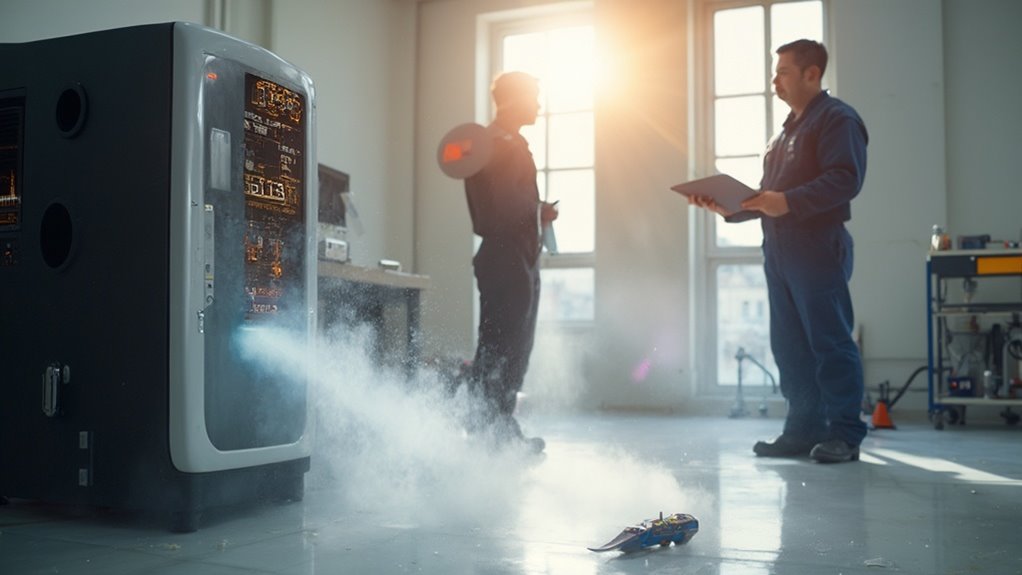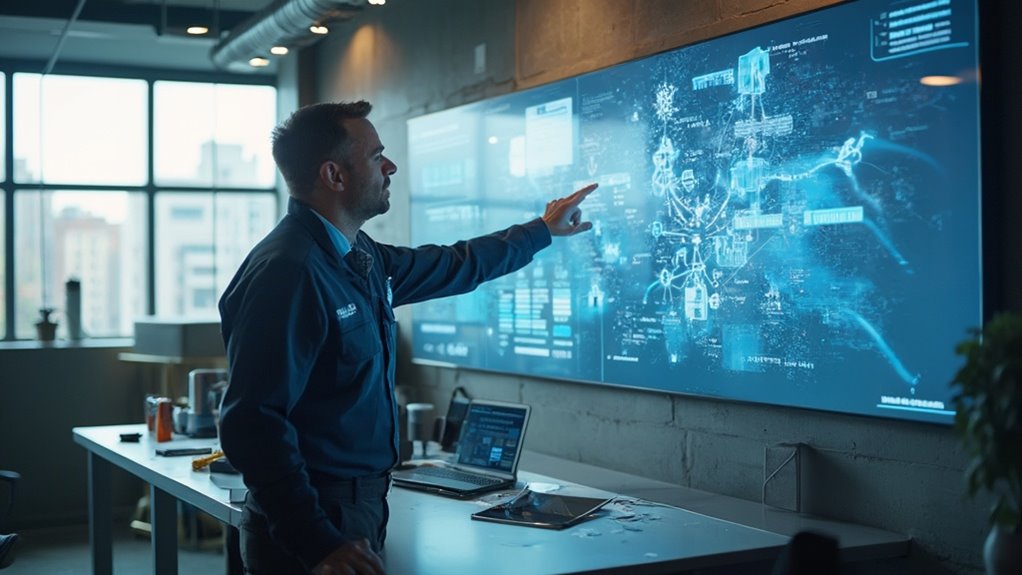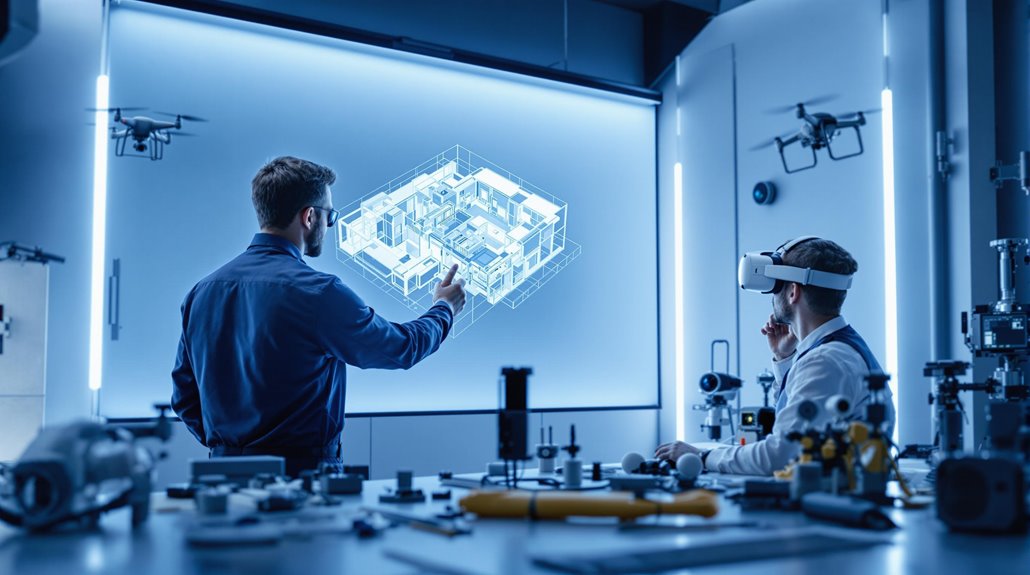Technology greatly boosts modern restoration services, making them faster and more effective. You can expect advanced damage assessments with tools like drones and 3D modeling. Rapid water removal is streamlined using high-efficiency extraction equipment, and effective drying practices prevent mold growth. Eco-friendly cleaning methods guarantee a safer environment for you and your loved ones. Improved project management through smart technology keeps everything on track, while IoT devices monitor for potential issues in real time. Embracing these innovations not only improves the restoration process but also supports a more resilient future. You'll uncover more aspects that transform restoration services.
Key Takeaways
- Advanced technology, including BIM and drones, enhances damage assessment and provides detailed visualization for effective restoration planning.
- Rapid response tools and high-efficiency equipment minimize water damage and reduce the risk of mold growth within critical timeframes.
- Precision drying techniques and industrial dehumidifiers ensure thorough moisture control, preventing structural damage and enhancing the comfort of occupants.
- Eco-friendly practices and advanced air filtration systems create healthier indoor environments while reducing the impact of harmful substances on occupants.
- Project management tools and IoT devices streamline communication, enhance real-time monitoring, and optimize resource allocation during restoration processes.
Assessment and Damage Evaluation

In today's restoration services, accurate assessment and damage evaluation are crucial for effective recovery. By integrating advanced technology, you can markedly improve your damage assessment capabilities. For instance, Building Information Modeling (BIM) creates detailed 3D digital models of properties, allowing you to visualize damage and plan restoration projects more efficiently. This technology helps you collaborate with stakeholders and reduces the risk of overlooking critical areas. Additionally, rapid response during water intrusion events is essential to mitigating damage effectively.
Furthermore, the deployment of drones and UAVs offers rapid and thorough aerial surveys, particularly in disaster-stricken regions. These tools provide real-time data, enabling you to allocate resources effectively and reduce response time. Drones can access hard-to-reach locations, ensuring a complete evaluation.
The integration of IoT and sensors likewise plays a pivotal role in damage assessment. These devices allow for real-time monitoring of environmental changes, like water leaks or humidity fluctuations, facilitating quick responses to emerging issues. Additionally, sales automation can enhance communication with clients during the assessment phase, ensuring that all parties are informed and engaged throughout the process. Finally, predictive analytics and AI can help forecast potential disasters and optimize resource allocation, streamlining your decision-making process. By embracing these technologies, you improve your damage assessment efforts and ultimately enhance restoration outcomes.
Water Extraction and Removal
When water damage strikes, advanced extraction techniques can make all the difference in your restoration efforts. Rapid response is essential to minimize property disruption and prevent further damage. By utilizing state-of-the-art equipment, you can quickly remove water and restore your space efficiently. Additionally, the use of industry-leading techniques ensures that every aspect of the water removal process is handled with expertise and precision.
Advanced Extraction Techniques
Advanced extraction techniques play a vital role in effective water extraction and removal, guaranteeing swift and thorough restoration after water damage. Using advanced detection tools like infrared cameras and moisture meters, you can pinpoint hidden moisture pockets and assess the severity of the damage accurately. This moisture assessment is critical for targeting your extraction efforts.
Employing high-efficiency extraction equipment, such as high-powered and hydraulic water extraction machines, allows you to remove standing water quickly and efficiently. These machines can handle large volumes, making them perfect for significant flooding situations. Vacuum extraction systems are particularly useful for drawing moisture from porous materials, guaranteeing extensive care for carpets and upholstery.
Specialized drying equipment, including industrial-grade dehumidifiers and high-capacity air movers, further promotes effective drying. These tools help prevent secondary water damage and mold growth by effectively reducing moisture levels in the air.
Incorporating thermal imaging technology and moisture mapping software into your restoration process guarantees that no damp areas are left untreated, solidifying your mastery in advanced extraction techniques. With these tools at your disposal, you're well-equipped to tackle even the most challenging water damage scenarios.
Rapid Response Importance
Rapid response is crucial in water extraction and removal, as every moment counts when it comes to minimizing damage. The first 48 hours are critical; if water lingers, it can worsen structural damage to materials like wood and drywall, potentially leading to costly repairs or even structural collapse. That's why having effective emergency preparedness and response protocols in place is important.
Advanced extraction equipment, including powerful pumps and vacuums, allows for swift removal of water, markedly reducing the risk of secondary damages like mold growth. Mold can begin to colonize within just 24 to 48 hours, posing health risks such as respiratory issues and allergies. By prioritizing rapid extraction, you not only protect your property but additionally safeguard the health of those who inhabit the space.
Furthermore, quick action increases the likelihood of salvaging valuable possessions, from furniture to documents. Utilizing advanced moisture detection tools guarantees you identify hidden water pockets, allowing for thorough extraction. Ultimately, the importance of rapid response in water extraction can't be overstated; it's the difference between recovery and extensive loss.
Minimizing Property Disruption
Minimizing property disruption during water extraction and removal is crucial for maintaining a comfortable environment for occupants. Advanced extraction equipment, like powerful pumps and hydraulic machines, quickly removes standing water, markedly reducing the time needed for complete water removal. This efficiency not only prevents further damage but likewise lays the groundwork for effective drying.
Modern restoration technology emphasizes noise reduction, using quiet, energy-efficient equipment that minimizes disturbance during the extraction process. High-speed air movers and industrial-grade dehumidifiers work swiftly to evaporate moisture and remove humidity, ensuring a smooth drying process without compromising occupant comfort.
Moreover, moisture detection tools like thermal imaging cameras and moisture meters allow for noninvasive assessments, identifying hidden water pockets without tearing down walls. This precision reduces structural damage and keeps disruptions to a minimum.
With digital documentation and remote monitoring, you can track the restoration process efficiently, further enhancing the experience for occupants. By leveraging advanced technology, restoration services not only expedite water removal but also prioritize a comfortable, less intrusive environment for everyone involved.
Drying and Dehumidification

When it comes to restoring water-damaged spaces, effective drying and dehumidification are vital for preventing further issues like mold growth and structural damage. You'll want to leverage advanced equipment like industrial air movers and low grain refrigerant (LGR) dehumidifiers to achieve ideal moisture control and drying efficiency. These tools generate strong airflow and efficiently extract moisture, greatly reducing drying times.
Utilizing centrifugal air movers and structural drying equipment helps target airflow and reach hard-to-dry areas, guaranteeing no moisture lingers in wall cavities or beneath flooring. Additionally, precision drying techniques like temperature control and moisture monitoring allow you to create perfect conditions for evaporation, mitigating the risk of microorganism growth.
Adapting your approach based on the specific situation is key. By tailoring drying strategies to the type of construction and water category, you secure thorough drying and prevent secondary damage. Immediate response is vital; the sooner you begin flood cleanup and drying, the better your chances of preserving structural integrity. With professional expertise and strategic equipment placement, you can master the art of drying and dehumidification in water damage restoration.
Cleaning and Sanitizing
When it comes to cleaning and sanitizing, you can leverage eco-friendly solutions that are both effective and safe for the environment. Advanced air filtration systems likewise play a vital role in improving indoor air quality, ensuring that harmful particles are removed. Together, these technologies create a healthier space for you and those around you.
Eco-Friendly Cleaning Solutions
Eco-friendly cleaning solutions are transforming the way we maintain our spaces while prioritizing health and sustainability. By utilizing sustainable ingredients like plant-based oils, citrus, and baking soda, these products not only clean effectively but likewise reduce your environmental impact. You'll enjoy various health benefits, especially if you have children or pets around, as these solutions are safer than traditional chemical cleaners.
Consider the invigorating scent of natural citrus, the gentle touch of baking soda, and the powerful action of enzymes—all working together to create a cleaner space.
- Experience a home that smells fresh without harsh chemicals.
- Enjoy peace of mind knowing your environment is healthier.
- Contribute to a sustainable future with biodegradable products.
While these eco-friendly options may require a bit more effort for ideal results, the long-term benefits far outweigh the initial challenges. As you adopt these solutions, you're not only nurturing a healthier living space but additionally supporting a greener planet. Make the switch today, and witness the transformation in your cleaning routine while making a positive impact on your health and the environment.
Advanced Air Filtration Systems
Maintaining a clean environment goes beyond just using eco-friendly cleaning solutions; it also involves ensuring the air you breathe is free from harmful pollutants. Advanced air filtration systems play a vital role in achieving ideal air quality. By utilizing activated carbon filters, you can effectively reduce VOCs and other airborne contaminants, especially when integrated into main air ducts or standalone purifiers.
HEPA and ULPA filters are fundamental for environments requiring high air asepsis, capturing 99.97% of particles down to 0.3 μm, including bacteria and viruses. These filters improve filter efficiency and safeguard indoor spaces like hospitals and clean rooms.
Furthermore, UV and hydroxyl technologies provide continuous air sanitization by destroying pathogens and mitigating odors. Systems like AeroPure SFS combine multiple filtration methods, achieving an impressive 99.99% efficiency at 0.007 microns, while inhibiting the growth of mold and other harmful microorganisms.
Project Management and Communication

Effective project management and communication are critical for the success of restoration services. By leveraging technology, you can improve project tracking and support team collaboration, ensuring that every project runs smoothly from start to finish. Utilizing project management software allows you to:
- Monitor real-time progress with ease, ensuring timely completion.
- Keep important resources like air scrubbers and dehumidifiers readily available, preventing budget overruns.
- Automate administrative tasks, freeing up your team to focus on key aspects of restoration.
These tools not only streamline project workflows but also help manage client expectations. When you have accurate data on scheduling and resource allocation, you're better equipped to justify any delays or budget changes. Instant communication among team members and stakeholders is vital, so using advanced tools to maintain synced calendars and built-in project journals can lead to a collaborative environment. Ultimately, mastering these project management techniques will improve your operational efficiency, ensuring that your restoration projects are completed to the highest standards. Adopt technology, and watch as it transforms your approach to project management and communication in the restoration field.
Preventative Measures and Future Technologies
In the domain of restoration services, implementing robust preventative measures can considerably reduce the risk of future damage. By integrating advanced technology into your preventative strategies, you can effectively safeguard properties against various environmental threats.
| Preventative Measure | Technology Integration |
|---|---|
| Structural Reinforcement | Smart sensors for real-time monitoring |
| Water Damage Prevention | IoT devices for leak detection |
| Fire Mitigation Techniques | AI-driven fire safety assessments |
| Energy Systems Upgrades | Smart grid technologies for efficiency |
Consider structural reinforcement, where smart sensors can monitor building integrity. For water damage prevention, IoT devices alert you to leaks before they escalate. Fire mitigation becomes proactive with AI-driven assessments, while energy upgrades can utilize smart grids for improved management.
These future technologies not only improve the effectiveness of your preventative measures but additionally streamline restoration processes. By adopting these methods, you're not only preserving property but equally ensuring a sustainable approach to restoration. Welcome the synergy between technology integration and preventative strategies for a resilient future.
Conclusion
In today's fast-paced world, technology isn't just a tool; it's the superhero of modern restoration services. From precise damage assessments to efficient water extraction and drying, tech transforms chaos into order. With seamless project management and innovative preventative measures, you can trust that your restoration needs are met swiftly and effectively. Embracing these advancements not only safeguards your property but additionally guarantees peace of mind, making your recovery journey smoother than ever before.







